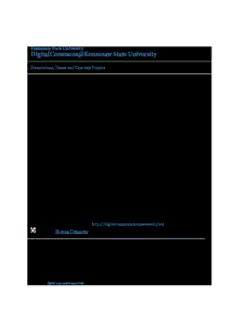
Association Between Nurse Staffing Indicators, Patient Falls, and Hospital Acquired Pressure PDF
Preview Association Between Nurse Staffing Indicators, Patient Falls, and Hospital Acquired Pressure
Kennesaw State University DigitalCommons@Kennesaw State University Dissertations, Theses and Capstone Projects 9-25-2014 Association Between Nurse Staffing Indicators, Patient Falls, and Hospital Acquired Pressure Ulcers in the Acute Care Setting Cheryl Renee Moates Kennesaw State University, [email protected] Follow this and additional works at:http://digitalcommons.kennesaw.edu/etd Part of theNursing Commons Recommended Citation Moates, Cheryl Renee, "Association Between Nurse Staffing Indicators, Patient Falls, and Hospital Acquired Pressure Ulcers in the Acute Care Setting" (2014).Dissertations, Theses and Capstone Projects.Paper 643. This Thesis is brought to you for free and open access by DigitalCommons@Kennesaw State University. It has been accepted for inclusion in Dissertations, Theses and Capstone Projects by an authorized administrator of DigitalCommons@Kennesaw State University. For more information, please [email protected]. ASSOCIATION BETWEEN NURSE STAFFING INDICATORS, PATIENT FALLS, AND HOSPITAL ACQUIRED PRESSURE ULCERS IN THE ACUTE CARE SETTING by CHERYL MOATES A Thesis Presented in Partial Fulfillment of Requirements for the Degree of Master‟s in Nursing Science in the Wellstar College of Health and Human Services Kennesaw State University Kennesaw, GA 2014 ACKNOWLEDGEMENTS I would like to express my sincere appreciation to my thesis chair, Dr. Patricia Hart. She has been a constant source of support and inspiration. She was always available to offer guidance when I needed direction and encouragement when I was feeling overwhelmed. She is truly a role model for all nurses and genuinely demonstrates and cultivates a commitment to lifelong learning. I would also like to thank my co-chair, Dr. Nancy Ballard. Her dedication and commitment to the profession of nursing is an inspiration to all nurses. Her knowledge and advice were invaluable in the writing of this thesis. Finally, I would like to thank my family. I would like to thank my daughters and son-in-law who are always loving and supportive throughout all my endeavors. My daughters, who have also been working toward a degree, understand the commitment, and we have motivated each other. My father has always been my champion and a constant source of love. I wish my mother was still present to witness my accomplishment, but her spirit has been with me throughout this venture. Both my parents exemplified the spirit of lifelong learning by committing their lives to teaching others. My extended family has supported me in pursuing my education and my career goals. Without everyone‟s support, this thesis would not have been possible iii TABLE OF CONTENTS ACKNOWLEDGEMENT ................................................................................................. iii TABLE OF CONTENTS ................................................................................................... iv TABLE OF FIGURES .........................................................................................................v TABLE OF TABLES ........................................................................................................ vi ABSTRACT ...................................................................................................................... vii CHAPTER 1: INTRODUCTION ........................................................................................1 CHAPTER 2: REVIEW OF LITERATURE .....................................................................10 CHAPTER 3: METHODS .................................................................................................27 CHAPTER 4: RESULTS ...................................................................................................34 CHAPTER 5: DISCUSSION .............................................................................................37 REFERENCES ..................................................................................................................51 APPENDIX A: Nursing Research Committee Approval ..................................................59 APPENDIX B: Permission to use NDNQI® Data ............................................................60 APPENDIX C: IRB Approval ...........................................................................................61 iv TABLE OF FIGURES Figure 1. Quality Health Outcomes Model .........................................................................5 v TABLE OF TABLES Table 1: Means and Standard Deviations for TNHPPD, RNNHPPD, Staffing and Resource Adequacy, Patient Falls, and HAPU ..........................................................35 Table 2: Correlation Matrix between TNHPPD, RNNHPPD, Staffing and Resource Adequacy, Patient Falls, and HAP ............................................................36 vi ABSTRACT Purpose: To determine if there is an association between nurse staffing indicators, direct care nurses‟ perceptions of staffing and resources adequacy, patient falls, and hospital acquired pressure ulcers. Design: A non-experimental, descriptive, correlational design using secondary data was used. Methods: The study took place at a large metropolitan hospital located within the southeast United States. Unit level data for 11 medical-surgical nursing units from the hospital‟s National Database for Nursing Quality Indicators survey conducted in October 2011 were obtained. Results: A statistically significant relationship was found between TNHPPD and RNNHPPD. No statistically significant relationship was found between nurses‟ perception of staffing and resource adequacy as it relates to patient falls and pressure ulcers. In addition, there was no statistically significant relationship between nurse staffing indicators and patient falls and HAPU among the 11 acute care hospital units studied. Conclusion: Additional research at the unit level is indicated to focus on evidence based practices that promote a culture of patient safety and enhance quality outcomes. The nursing sensitive outcomes of patient falls and HAPU will be reported in the public domain. Therefore, it is important for hospitals to understand the dynamics associated with nurse characteristics, patient risk factors, and organizational framework that impact the patient care delivery models that produce quality outcomes. vii Keywords: nursing hours per patient day, nursing process, patient falls, pressure ulcers, patient outcomes, patient care delivery models, staffing and resource adequacy. viii 1 CHAPTER 1: INTRODUCTION Quality patient care is an area of major concern within healthcare systems (Kavanagh, Cimiotti, Abusalem, & Coty, 2012). The United States (U.S.) spends more on healthcare than any other industrialized nation, over 16% in 2008, according to the U. S. Department of Health and Human Services (DHHS) (Shi & Singh, 2012), but continues to rank poorly in the area of quality outcomes. Consumers are dissatisfied with the current healthcare system. Patients are experiencing adverse events in hospitals and nurses feel overwhelmed by daily responsibilities. Healthcare costs are skyrocketing and the number of uninsured increases daily (Russell, 2012). As a result, the U.S. has initiated the Affordable Care Act (ACA) to address the issues of costs, hospital performance, and patient outcomes (U.S. DHHS, Health and Human Services, 2014). A skilled nursing staff is fundamental to providing quality patient care. A hospital cannot achieve quality outcomes without an adequate nursing workforce. In an era of reform, when cost constraints are so significant, it is important to provide data that supports an effective nursing workforce which will meet patient needs and positively impact nursing sensitive outcomes. This chapter presents the purpose of the study, background and significance, statement of the problem, and the theoretical framework that guides this study. Research questions, definitions, assumptions, and limitations for the study will be included in this chapter.
Description: